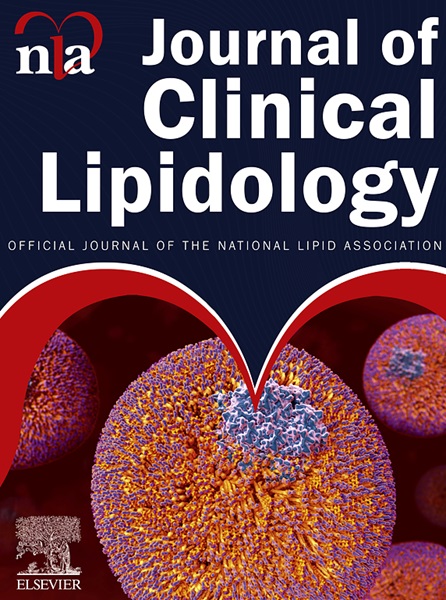Lipoprotein(a) levels in a population with clinical atherosclerotic cardiovascular disease in the United States: A subanalysis from the Lp(a)HERITAGE study
IF 3.6
3区 医学
Q2 PHARMACOLOGY & PHARMACY
引用次数: 0
Abstract
BACKGROUND
Elevated lipoprotein(a) (Lp[a]) is the most common inherited dyslipidemia that is independently and causally associated with increased atherosclerotic cardiovascular disease (ASCVD) risk. However, data from diverse populations with ASCVD are lacking.
OBJECTIVE
To evaluate Lp(a) levels in a diverse, contemporary United States (US) population with ASCVD, stratified by race, ethnicity, and sex.
METHODS
Lp(a)HERITAGE (NCT03887520) was a multicenter study that estimated the prevalence of elevated Lp(a) in adults (18–80 years) with ASCVD. US participants with Lp(a) measured in nmol/L pre- or post-enrollment were included in this subanalysis. This study was descriptive; therefore, no statistical comparisons were made.
RESULTS
Of all US participants, 14% had an Lp(a) measurement pre-enrollment. This subanalysis included 7679 US participants with Lp(a) measurements in nmol/L (80.5% White; 66.4% male; mean age 63.8 years [standard deviation ± 9.7]). Median Lp(a) was > 2.5-fold higher in Black participants (132.0 nmol/L; IQR, 57.1–239.6) vs the overall population (52.1 nmol/L; IQR, 15.7–167.8), and higher in females compared with males (69.4 nmol/L; IQR, 20.1–194.7 vs 45.6 nmol/L; IQR, 14.0–152.6, respectively). Lp(a) levels ≥ 125 nmol/L were more prevalent among Black (52.0%) and female (38.9%) participants vs the overall population (33.3%).
CONCLUSION
In US Lp(a)HERITAGE participants, only 14% had an Lp(a) measurement pre-enrollment, despite having ASCVD. One-third of participants demonstrated Lp(a) levels ≥ 125 nmol/L, the threshold for high ASCVD risk, which was higher among Black (1/2) and female (2/5) participants, suggesting a greater need for Lp(a) testing in these groups to inform ASCVD risk mitigation.

美国临床动脉粥样硬化性心血管疾病人群的脂蛋白(a)水平:来自Lp(a)HERITAGE研究的亚分析
背景:脂蛋白(a)升高(Lp[a])是最常见的遗传性血脂异常,与动脉粥样硬化性心血管疾病(ASCVD)风险增加独立且有因果关系。然而,缺乏来自不同ASCVD人群的数据。目的:评估不同种族、民族和性别的当代美国ASCVD患者的Lp(a)水平。方法:Lp(a)HERITAGE (NCT03887520)是一项多中心研究,旨在估计成年(18-80岁)ASCVD患者Lp(a)升高的患病率。在入组前或入组后以nmol/L测量Lp(a)的美国参与者被纳入该亚分析。这项研究是描述性的;因此,没有进行统计学比较。结果:在所有美国参与者中,14%在入组前有Lp(a)测量。该亚组分析包括7679名美国参与者,Lp(a)测量单位为nmol/L (80.5% White;男性66.4%;平均年龄63.8岁[标准差±9.7])。黑人受试者的中位Lp(a)是黑人受试者的2.5倍(132.0 nmol/L;IQR, 57.1-239.6) vs总体人群(52.1 nmol/L;IQR为15.7-167.8),且女性高于男性(69.4 nmol/L;IQR为20.1 ~ 194.7 vs 45.6 nmol/L;IQR,分别为14.0-152.6)。Lp(a)水平≥125 nmol/L在黑人(52.0%)和女性(38.9%)参与者中比总体人群(33.3%)更为普遍。结论:在美国Lp(a)HERITAGE参与者中,尽管患有ASCVD,但只有14%的参与者在入组前进行了Lp(a)测量。三分之一的参与者显示Lp(a)水平≥125 nmol/L,这是ASCVD高风险的阈值,在黑人(1/2)和女性(2/5)参与者中更高,这表明在这些组中更需要Lp(a)检测以告知ASCVD风险缓解。
本文章由计算机程序翻译,如有差异,请以英文原文为准。
求助全文
约1分钟内获得全文
求助全文
来源期刊
CiteScore
7.00
自引率
6.80%
发文量
209
审稿时长
49 days
期刊介绍:
Because the scope of clinical lipidology is broad, the topics addressed by the Journal are equally diverse. Typical articles explore lipidology as it is practiced in the treatment setting, recent developments in pharmacological research, reports of treatment and trials, case studies, the impact of lifestyle modification, and similar academic material of interest to the practitioner.
Sections of Journal of clinical lipidology will address pioneering studies and the clinicians who conduct them, case studies, ethical standards and conduct, professional guidance such as ATP and NCEP, editorial commentary, letters from readers, National Lipid Association (NLA) news and upcoming event information, as well as abstracts from the NLA annual scientific sessions and the scientific forums held by its chapters, when appropriate.

 求助内容:
求助内容: 应助结果提醒方式:
应助结果提醒方式:


